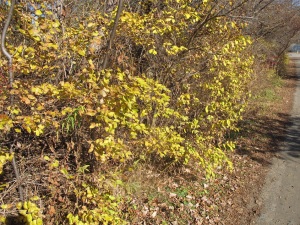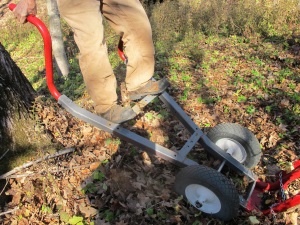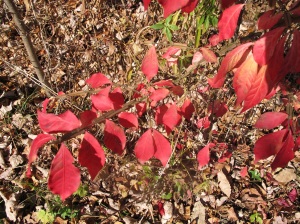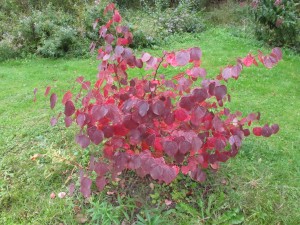Invasive Plants
Going for a walk the other day along a public trail I was struck by the number of invasive shrubs I saw. Most trees and shrubs have shed their leaves, but burning bush (Euonymus alatus), Japanese barberry (Berberis thunbergii) and honeysuckle (Lonicera spp.) still have leaves on their branches. Holding leaves and producing food by photosynthesis gives them extra energy to take over the world (or their world, anyway). This is a good time to pull a few of these out because many are very visible right now.
Why bother, you might ask? Because these invasive plants which come from the China or Japan have no natural enemies here. Left alone, they can take over the landscape, outcompeting our native wildflowers and understory shrubs, although that may take decades. In some places they have created monocultures by elbowing out other plants. Most birds, mammals and insects have evolved while depending on native species for their food and shelter. Do these shrubs provide food? Yes, but it is often not of the same quality as that of our native species.
Cutting down invasive shrubs will not necessarily kill them. Some invasive trees and shrubs react by sending up multiple new shoots from their roots. Instead of one buckthorn, for example, you suddenly have several in a circle around the tree you cut down. That increases the problem instead of solving it.
I have found that buckthorns can be killed without producing the root suckers if I double girdle the tree. By this I mean I cut a ring around the tree with a pruning saw, and then cut another ring a foot higher or lower than the first cut. I cut through the bark and the green cambium layer, but do not cut into the heartwood. If I do this now, the tree will leaf out next spring and the following spring, but slowly die by the third year. Patience is the key. The technique allows you to slowly starve the roots – they can’t get any nutrition from the leaves. Many buckthorns have multiple stems, and you must girdle every one to kill the roots.
For small to medium sized invasive trees and shrubs, pulling them up is another option. I recently met with Gerry Hawkes, an inventor and forester in Woodstock, Vermont to try out a tool he developed to pull invasives (and do other tasks such as hauling firewood and moving large stones). It is a sturdy, 2-wheeled device that uses leverage to pull up a tree, roots and all. We pulled an inch-and-a-half buckthorn tree and a full size multi-stemmed honeysuckle with a trunk that was over three inches in diameter at the base.
The tool we used is called a Wheeled Post and Shrub Puller (http://
We looped a light chain around the base of the tree and then attached it to one of four notches on the puller to allow us to begin with the best mechanical advantage, which is 12:1. I pulled down on the handle using my weight and it lifted the buckthorn partially out of the ground. Then, to get an even higher lift, we reset the chain to a different notch on the front of the tool and I got the root system right out of the ground! Since this tool is on 16 inch wheels, I was able to roll the tree away with little effort.
I have also used a hand tool called a Weed Wrench that pulls small trees and shrubs. Unfortunately, the company that makes these tools has gone out of business. It was made in four sizes with a gripping mouth-part that clamps down on a trunk, and a handle that uses leverage to pry out shrubs. Two other companies are now marketing similar tools, The Uprooter (www.theuprooter.com) and the Pullerbear (www.pullerbear.com). From what I have read, neither would compete with the tool I tried last week for pulling larger shrubs and small trees.
I think that using mechanical advantage to pull invasives makes much more sense than using chemical herbicides. But I don’t have personal experience following up over several years with invasives pulled: will the scraps of roots left in the ground survive and re-sprout? It’s possible that they will. Still, I think that Conservation Commissions and Garden Clubs would be well served by investing in pulling devices to share with interested townspeople and using along public pathways.
There are no plant police. No one can tell you that your invasive shrubs must be pulled up. Nurseries may not sell them, propagate them or transport them. But I am working hard at removing mine. And even if you live in a city, it makes sense to remove invasive plants on your property. Their seeds may wash down storm drains, and end up in a wetland or river – and spread their genetic material.
Getting rid of invasive plants takes time. I recently chatted with a woman who removed all the burning bush on her property 12 years ago. She is still pulling seedlings that germinate from seeds deposited over a decade ago. But, on the positive side, pulling “thugs” gives you more room to plant other nice landscape plants. So go look for invasive plants now, and try to get rid of a few.
Henry Homeyer is a gardening consultant and coach. He speaks to garden clubs and civic organizations about many aspects of gardening. Contact him at henry.homeyer@comcast.net or visit his website, www.Gardening-Guy.com.
Fall Color
Some years ago, in a moment of enlightenment, the New Hampshire legislature outlawed the propagation, transport and sale of three popular landscape plants: burning bush, barberry, and Norway maple. All three had been proven to be invasive, seeding into the woods and crowding out our native plants. Both Massachusetts and Connecticut have banned them, too, but so far Vermont, Maine and Rhode Island have not.
I agree with the ban. All three are thugs. Even where banned, the plant police will not come and take away your invasive plants, although I do recommend that you pull yours and replace them. I also understand why so many people love burning bush (Euonymus alatus), especially now when it displays brilliant red foliage. It will grow anywhere and stays a nice size.
There are good alternatives to burning bush that will provide good – even spectacular – fall color. The best I can recommend is fothergilla (Fothergilla spp.). This is a small to medium sized shrub with gorgeous white bottlebrush flowers in April and brilliant leaves starting now. It is slow growing, so it need not be pruned often, which I consider an advantage. The fall foliage can range from red and purple to yellow and orange – and I’ve had all 4 colors on one plant. A named variety, ‘Mt Airy’, is one of the best.
The common blueberry is another nice shrub that has red and yellow leaves in fall. The white blossoms in June are nice – and who knows, you might even beat the birds to a few berries. The trick to success with the berries is to get the soil very acidic by adding garden sulfur to the soil, or, right after flowering, add an acid fertilizer like Holly-Tone or Pro-Holly. But don’t add fertilizers now – you don’t want any soft new growth just before the winter.
Another great plant for fall color is redbud hazel (Disanthus cercidifolius). It is not commonly found in garden centers, but I predict it will be: the leaves turn a brilliant claret red to purple early in the autumn. I got one last year and it suffered from the cold winter with some branches dying back. It also was munched by deer. But it rebounded nicely this summer, and is putting on a great show. According to Professor Michael Dirr’s books, it might reach 6 to 10 feet tall, and does well in partial shade and moist, rich soil. Dirr says it is hardy to minus 20, and we saw temperatures colder than that last winter, so I should be glad mine survived.
Spirea is the common (and scientific) name for a group of shrubs commonly planted around post offices and municipal buildings. It is what I think of as an “urban survivor”. Like that banned burning bush, it requires little and will survive almost any conditions. There are some varieties that have excellent fall color. ‘Glow Flame’ and ‘Glow Girl’ are varieties with good red color that I have seen, though, not grown.
Some azaleas also develop good red colors. ‘Cornell Pink’ is a very early- blooming azalea that also has excellent red leaves right now – in some places, but not others. I saw two examples growing side-by-side. One had a nice burnt red color, the other had leaves that were still an ordinary green. Beats me why one should turn color, the other not.
Both the double file viburnum (Viburnum plicatum) and arrowwood viburnum (Viburnum dentatum) often have excellent red fall color. But like the azaleas mentioned above, there is limited consistency. If you want to get a specimen that shows good color, buy one with good color at the nursery and plant it now. Both produce nice white flowers in the spring and produce berries in late summer that are relished by birds. They are medium-sized shrubs that are pleasant additions to the landscape.
One word of warning: there is a viburnum leaf beetle, a foreign pest, that has recently appeared in the landscape and it can devour the leaves of viburnums and ruin their appearance – or even kill them. I’ve been told that this new pest came down from Montreal, so some northern gardens have been affected before those in southern locations.
One last suggestions to consider is the red chokeberry (Aronia arbutifolia. I bought one 10 years ago after reading about this species and seeing a specimen with brilliant foliage. What struck me was that the tops of the leaves in fall were red and the undersides were silver. But my specimen has not thrived, and I have moved it once on my property trying to find just the right place for it. It is generally said to be adaptable to soils and sun conditions, and the berries are so bitter that even the birds will not eat them. Still, it’s worth a look. My specimen has stayed about 6 feet tall.
As with anything we do in the garden, there are few guarantees when it comes to fall color. Burning bush? Yes. Red, year after year. And I’ve always been pleased with fothergilla. But even our favorite maples cannot be depended on to put on a spectacular show every year. So please don’t sue me if you pull out your burning bush and plant a spirea or a viburnum and it doesn’t perform as well! Each shrub we plant has its virtues.
Henry Homeyer is the author of 4 gardening books and is a UNH master Gardener. His web site is www.Gardening-Guy.com/.








